All photos by the author.
From a lofty brick throne, a voluptuous redhead rules over Adams Morgan, watching and goading all manner of revelry like a contemporary Doctor T.J. Eckleburg. Her territory spans the 18th Street strip; her image an iconic symbol of throbbing crowds, vodka cranberries, and Jumbo Slice pizza.
But just two blocks away from her Madam’s Organ palace stands evidence of a rich heritage that long precedes her reign. Near the corner of 18th and Adams Mill (and now overlooking a Zipcar parking lot), a community has danced, sung, painted and played in the faces of danger and greed for over thirty years, their history preserved in a three-story mural titled “A People without Murals is a Demuralized People.”
Originally painted in 1977 by Chilean brothers and artists “Caco” (Carlos) and Renato Salazar (the first of whom studied at the Corcoran and founded the now-defunct Centro de Arte organization), the work is touted as one of the oldest and largest of DC’s few remaining Latino murals, the last beacon of a wider Latino artistic movement in the city, according to Quique Aviles.
“It was…the heyday of the Nicaraguan [and] El Salvadorian [revolutions], so there was all this artistic, cultural movement in the city,” says Aviles, an El Salvadorian immigrant who landed in Columbia Heights in 1980. “This mural tradition [started] in the Latino community. A bunch of murals were painted.”
Unfortunately, only a handful have survived, he continues. Many were done on plywood panels on the sides of decrepit buildings, eventually torn down to make way for renovations and development projects. Sun-faded, rusting in some places and crumbling in others, the Salazars’ mural was slated to meet a similar fate. Aviles—by then an Adams Morgan resident, artist, activist, and founder of Sol y Soul (an organization promoting social justice through art)—fought to save it.
Through the support of the DC Commission on the Arts and Humanities, the Mayor’s Office of Latino Affairs, Ward 1 representative Jim Graham and various community organizations, Aviles secured funding to, in effect, remuralize the “Demuralized.” Over the course of three weeks in the summer of 2005, using latex and spray paints, graffiti artist Juan Pineda repaired the wall and repainted the work.
Some areas of the mural had so deteriorated that “I had to use my imagination to fill in the blanks,” explains Pineda, noting for instance that the once-vibrant reds had long-since faded to pink. Photos of the original piece guided his project; but to his surprise, the Latino community emerged in support, too.
“The coolest part [of the project] was having locals come up [and observe]…. A lot of them have been here for generations, and they all came and shared their stories with me…of the mural, little scenes here and there—what the neighborhood was like,” remembers Pineda. “[Many] offered me breakfast and lunch [while I worked]. They had a personal attachment.”
The mural is certainly striking enough to merit a fan club. Informed by the artist’s interest in Picasso at the time, the cubist accents render the piece at once vivid and demure, simplistic and perplexing. “The flat, plain colors with thick outlines gave the figures more strength and, [like] poster art of the 70s, a more powerful view at [a] distance,” says Caco in an e-mail regarding his original design. (The geometric shapes and straightforward coloring were a practical decision, too. As the original Centro de Arte team worked with area youth to complete the piece, “Quality control was difficult… I had to develop a quick technique…,” explains Caco.)
The composition is divided into three distinct but complementary pockets of activity: one along the bottom row, depicting community festivities; a second in the upper left corner—home life in greater detail; and a third in the upper right corner, consisting of a dark and suspicious trio of figures. On the far left, a large, white, ghost-like figure (a Big Brother-esque Cyclops according to The Washington Post; the Holy Spirit according to Pineda) seems to hold the three pockets in place, balancing the images as the eye follows the “yellow brick road” that connects them all.
But more than aesthetics, the mural’s appeal undoubtedly stems from its enduring message. Amid scenes of everyday neighborhood life—dancing, music and, in a nod to the artistic movement of the era, mural painting, symbols of corruption and danger pervade. At the center, one figure, his hands half-shielding his eyes, gazes in horror (or at least, bites his nails in anxiety) at a blazing television screen. Directly above it, the portrait of Augusto Pinochet (according to Pineda) hangs in a living room, his red eyes a menacing reminder of the Chilean dictator’s infamous cruelty—once a reality for some members of the community (or at least, for the Salazars). And sneakily, in the top right corner of the composition, it is three businessmen wearing suits and malicious grins, playing Monopoly with the neighborhood—raising rents and driving out immigrants.
Indeed, a plaque adjacent to the mural offers a brief description of the 2005 renovation, followed by a dedication in both English and Spanish “to all those who struggled to make – and keep – this neighborhood their home.”
“It’s an early depiction of life in a barrio,” admits Aviles, “But it was also demarcation of territory. We’re here. We have a voice. We paint.
“It’s important to retain [these] types of artistic statements, and to remind people in the city that even though there’s not as many of us because of the prices, the rent, that we still maintain a presence, we are part of the fabric of the city.”
Hear that, Madam?
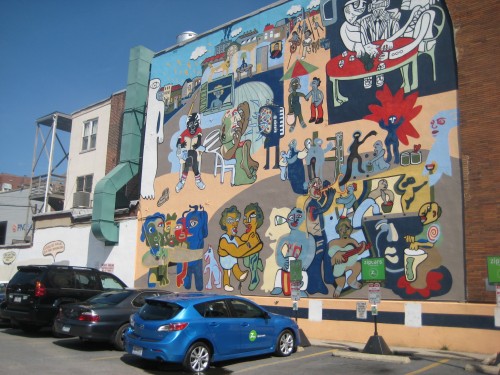
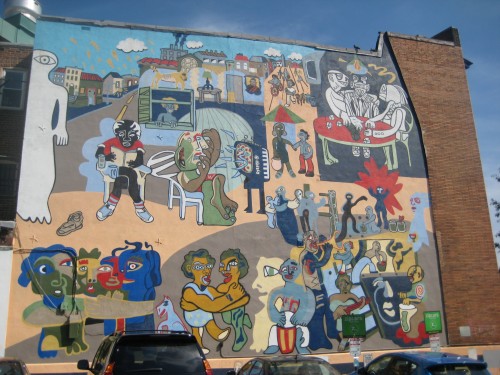
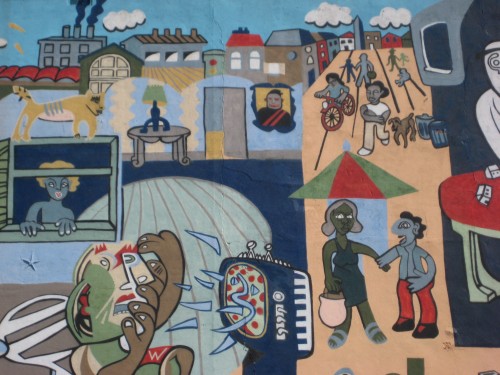
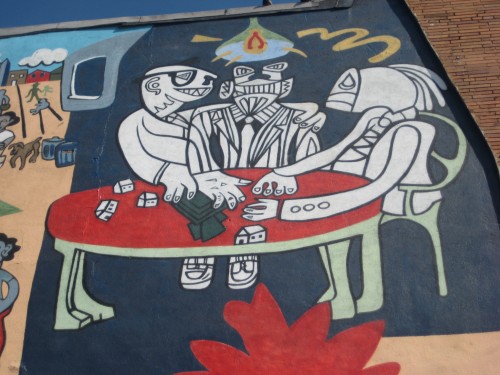
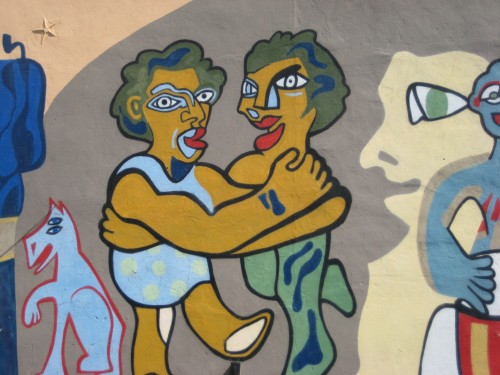
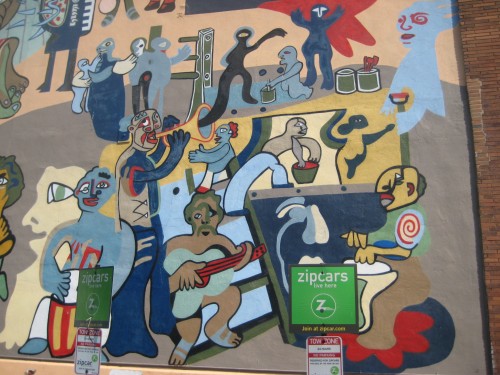
J, next time you blog about a mural in my hood, I’m coming along! Woohoo! Love this post.
This post is absolutely fabulous! Rarely does one come across a blog that is as thoughtful and beautifully composed as this one. The author is clearly an erudite blogger, researcher, and photographer.
This article is PURE GENIUS. I have never been so well-educamated as after reading this piece. I now look at Adams Morgan artwork in a whole new light.
Add me to the ‘Adams Morgan murals fan club’. Where’s the kleenex?